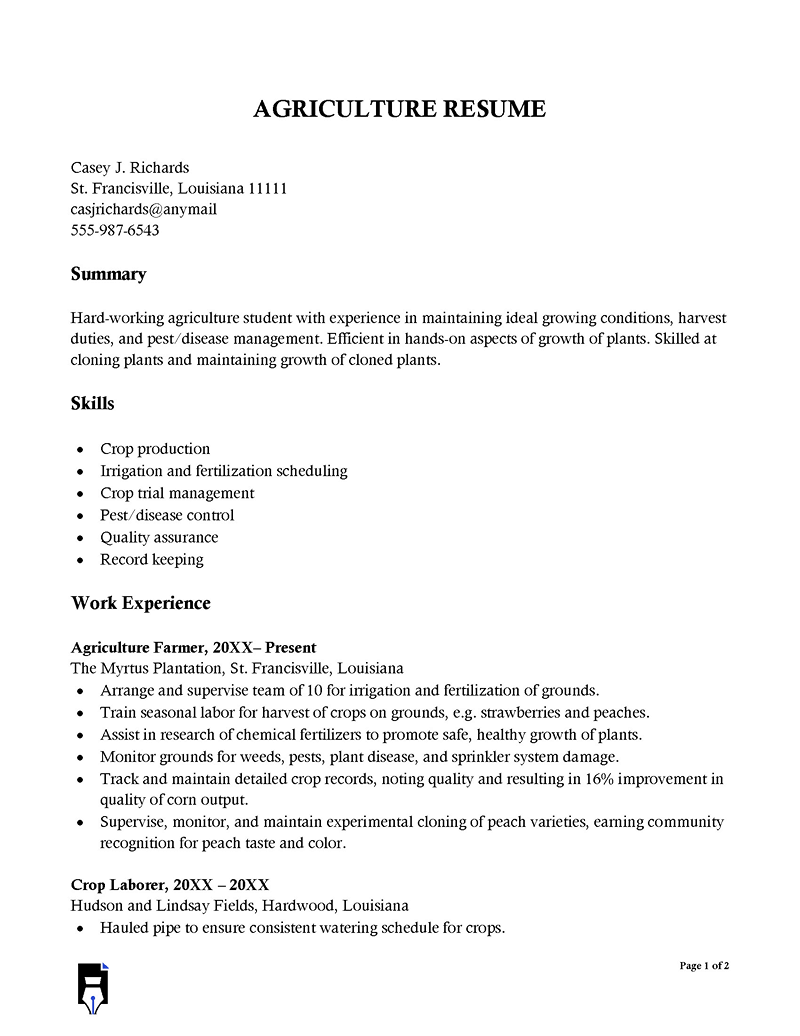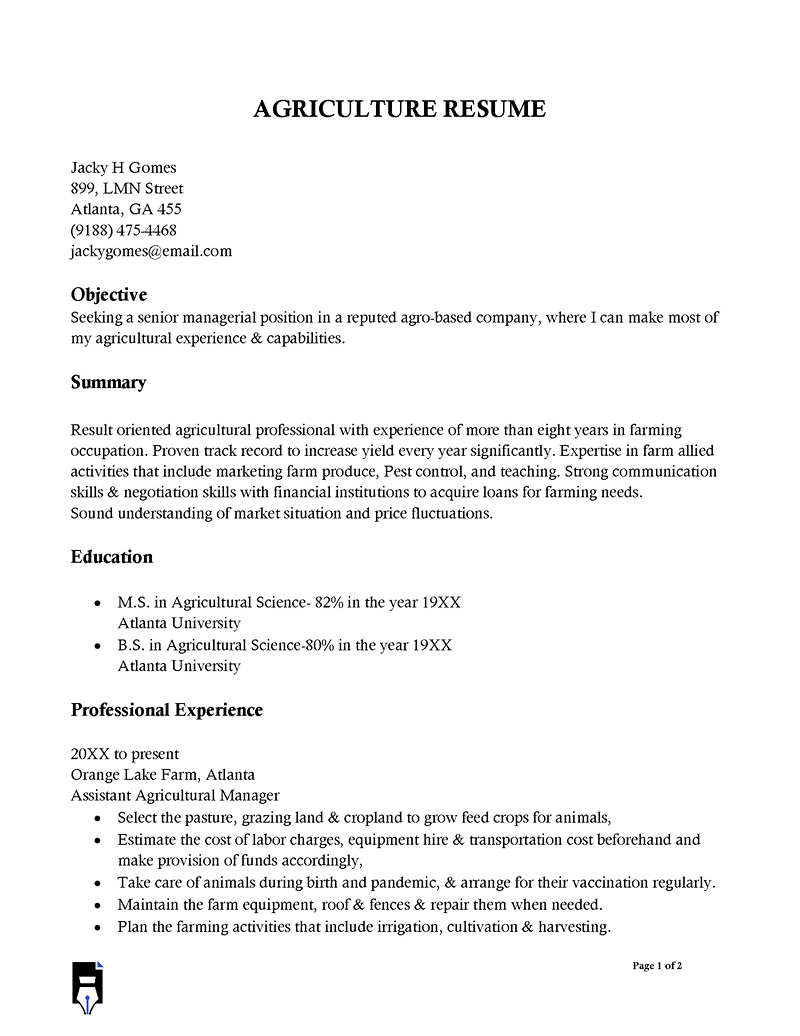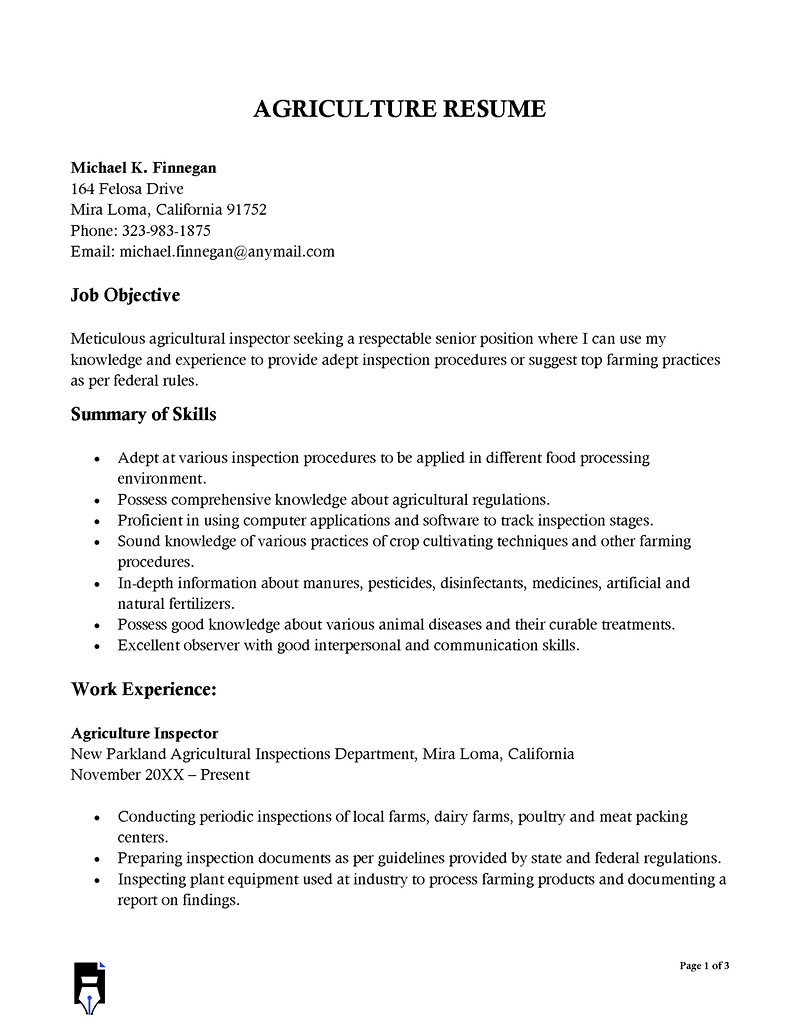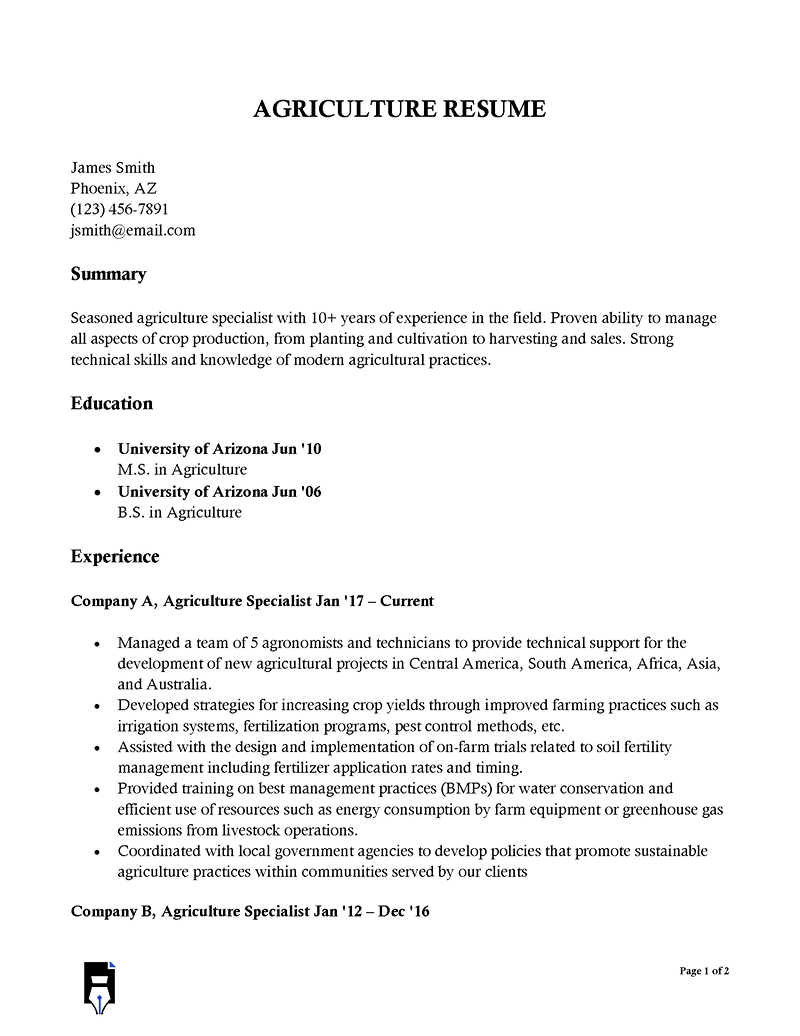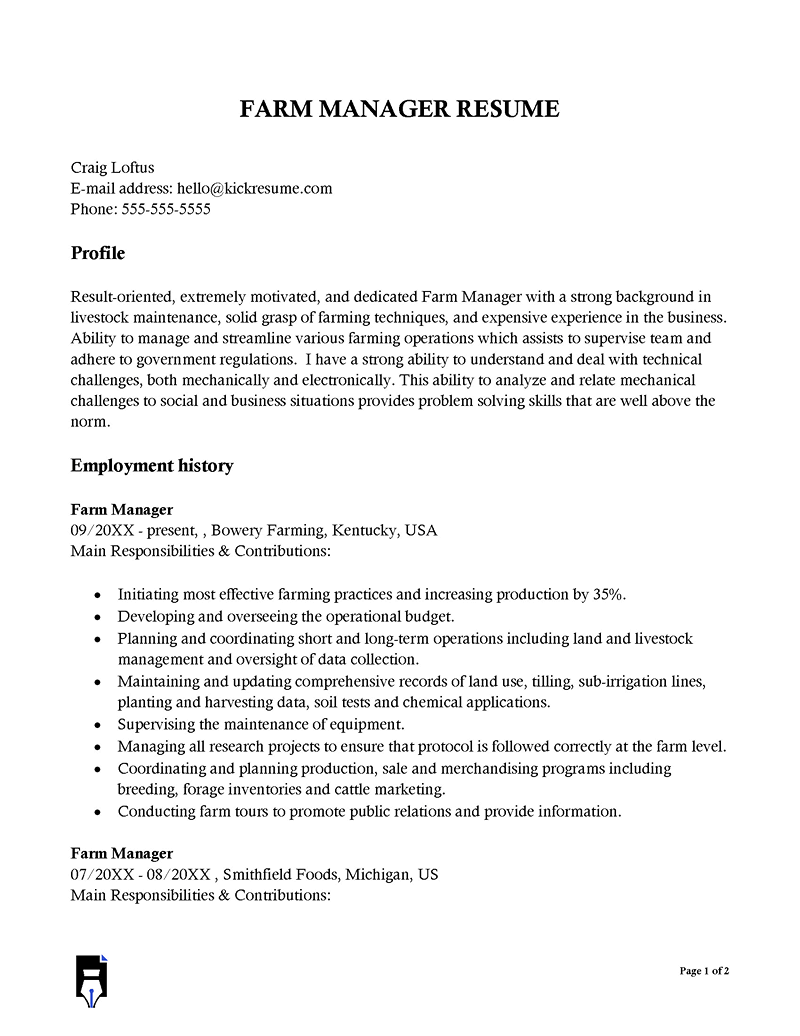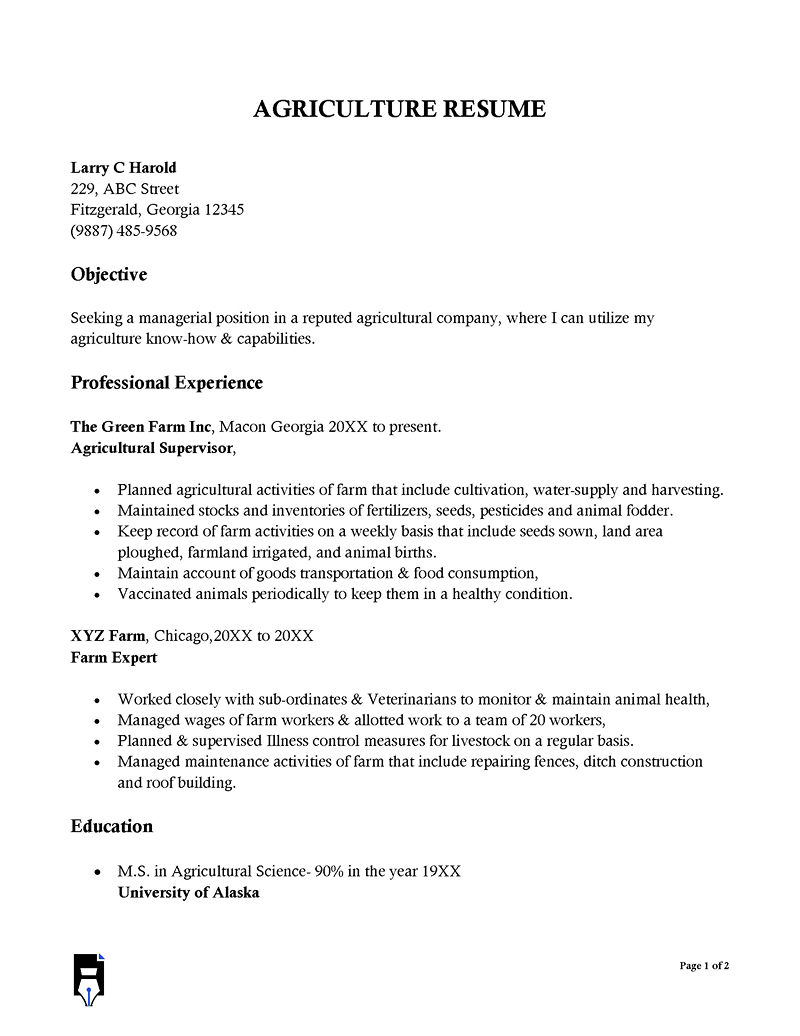An agriculture resume is a formal document that summarizes a job applicant’s competencies, skills, and experience that make them a suitable candidate for a job in the agriculture sector. The resume should show the candidate’s overall suitability for the particular position they are applying for.
The components of a resume include work history, educational background, relevant skills, and other details such as certifications that they may have. A resume is a primary document in any job application process. It serves as an introduction to potential employers. There are different job positions/roles in agriculture that you can pursue in your job search.
They include:
- Agricultural engineer
- Farm manager
- Farmhand
- Rancher
- Horticulturalist
- Farmworker
- Agricultural scientist
- Animal breeder
- Technician
- Food scientist
- Dairy farmer
- Greenhouse laborer
- Agricultural equipment operator
- Nursery worker
- Ranch hand
Agriculture Resume Templates
You can download the following templates for free:
Stats: According to the Bureau of Labor Statistics, jobs in the agricultural sector are projected to have the following changes from 2018-2028. (Ranchers, farmers, and other agricultural managerial jobs 1% decline), (agricultural worker positions 1% increase) (agricultural and food scientists jobs 7% increase), (agricultural and food science technician positions 6% increase), (agricultural positions 5% increase). Additionally, the bureau states that ranchers, farmers, and other agricultural managers receive a median salary of $67 950, agricultural workers $24 620, agricultural and food scientists $64 020, agricultural and food science technicians $40 860, and agricultural engineers $77 110.
This article comprehensively discusses the need for a template for an agriculture resume, its components, and how to write a resume when applying for a job in agriculture. The article also outlines the do’s and don’ts that improve the quality of your resume.
Why Should You Create Agriculture Resume?
Your resume should show your ability to perform different functions in the agriculture domain. Some of the general responsibilities of employees in agriculture are caring for crops and livestock. These duties include operational responsibilities such as inventory keeping, transportation, feeding, tagging, etc.
The resume should illustrate your knowledge regarding feedlot protocols and functions associated with other professions that deal with animal injuries and live births. Also, it is advantageous if you are familiar with field and office work, as it shows you can work on the farm and attend to livestock needs.
A resume is meant to propel you to the next stage in the hiring process. Therefore, you should use it to show your value to the prospective employer. It should align with the particular job opening you are applying for. Therefore, to write an exceptional resume, you must clearly understand the duties and responsibilities of the position you are applying for. The resume is thus an opportunity to market yourself to the hiring manager.
Which Resume Format is Best for Agricultural Worker?
Using the reverse-chronological format for your resume as an agricultural worker is advisable. This format focuses on work experience from the most recent job going backward. This thus allows you to outline how you have employed your skills and qualities in previous jobs. The reverse-chronological format is best suited for applicants with significant experience.
However, the format may not be suitable for applicants with little or no experience, such as recent graduates, individuals making a career change, or having significant gaps in their work history. These categories of applicants can opt for a functional format that focuses on skills and academic qualifications.
Alternatively, applicants can opt for a hybrid resume that combines the strengths of a reverse chronological format and a functional format. A functional format is suitable for applicants changing their career paths or if they have significant gaps in their employment history.
How to Write Agriculture Resume: 6 Key Steps
Writing an outstanding resume for an agriculture job may seem complex and challenging, but you can simplify the process with proper planning and the correct procedure. A good resume is persuasive, job-specific, and informative.
Below is a procedural guide on creating a resume that increases your chances of getting hired for the job:
List your contact details
Your resume should start with your contact details to help the hiring manager to identify who you are before reviewing the resume. Your contact details include your name, address with postal code, phone number, email address, professional website or portfolio, etc. This information is needed should the employer want to contact you to invite you for an interview or ask questions.
Examples:
Incorrect
Harley May 444 2098 8114
Correct
Harley May
204 Pretoria, FL | Phone: 442 02983 2222 | Email: [email protected]
Write a professional summary
You should consider including a summary in your resume because it is a way to introduce yourself to potential employers. A summary is a brief overview of your strengths and qualifications in relation to the job you are applying for. The summary can briefly mention your most noteworthy skills, experience, achievements, and interests. It can also outline your career goals. This information should be given in 2 or 3 sentences.
Examples:
Incorrect
Food scientist looking for a job at your company. I am a dedicated employee who performs assigned duties diligently. I am a suitable candidate for this position and would appreciate the opportunity if hired.
Correct
Food scientist with 5 years of experience in the processing industry. I have been dedicated to developing sustainable and resilient foods through genetic modifications. Part of the team who received the Humanity Armor Award, Food Security in 2021. I intend to continue promoting food security through my expertise, and a job at your company would be a step toward this goal.
Highlight your work history
Your resume should then showcase your work history. This section is typically the most extensive section of your resume. It can be advantageous if your work history demonstrates your experience operating different equipment or machinery. You can discuss your ability to perform general repairs and maintenance. However, you can also state your specialty, whether it is crop or livestock production.
The information included in this section will depend on how experienced you are in your profession, whether you are a student, intern, or established employee. You should start with the most recent job and list the rest in reverse chronological order. The duties and achievements under each job position should be written in bullet points. You should also incorporate figures and keywords obtained from the job description in this section to show your suitability for the position.
Examples
Incorrect
–Maintained machinery in the factory
–Undertook administrative duties whenever needed
–Led a team tasked to process raw materials into finished products
Correct
–Operated and maintained different types of machinery such as boilers, conveyor belts, packaging equipment, and mixers
–Undertook administrative tasks such as report writing, preparing equipment operation manuals, and preparing budgets for the O&M division
–Led a team of 10+ members that were responsible for operating and maintaining machinery within the factory
Pro tip: Jobs in agriculture are not limited to caring for crops and livestock. Some jobs require you to operate, maintain and repair machinery and structures. You, therefore, must be equipped with different skill sets to have an advantage over competitors.
Include relevant education and certifications
Academic qualifications are key criteria for determining suitability for a job position. This section should also be arranged in reverse-chronological order, starting with the most recent qualification. Under this section, you should name the institution, location, start and completion dates, level of achievement, and honors. However, you should only include your highest academic qualifications. You can include other qualifications that are highly relevant to the specific job.
Examples
Incorrect
B.Sc. in Food Scientology, 2014
Certified Agricultural scientist
Correct
BSc in Food Scientology | Cumberland College
Nipawin, Canada
–Major: Food genetics and anatomy
–Graduated: 2018
–GPA: 3.8
Certifications
–Certified Food Scientist (CFS) | University of Florida
–Safety Quality Food (SQF) | University of Michigan
Add your skills and accomplishments
Next, you should enlist your skills. The skills in your resume should align with the agriculture job you are applying for, as different jobs will require you to perform different functions. Review the job description and identify the associated duties to ensure you provide relevant skills. Some employers may be looking for specific skills, relevant experience with machinery, and certifications, so paying attention to such expectations is necessary.
Your resume should have both technical and interpersonal skills. Interpersonal skills such as communication can be an asset to employers. This is because interpersonal skills are needed to engage with other professionals regardless of whether you will work independently or collaborate with other agriculture professionals.
Examples:
Technical skills
| Farm machinery | Equipment maintenance |
| Fertilization processes | Harvest Scheduling |
| Waterline and temperature controls | Irrigation systems |
| Mechanical repairs | Motorized equipment operation |
| Livestock and crop care and management | Waterway construction |
Interpersonal skills
| Teamwork | Collaboration |
| Multi-tasking | Verbal and written communication |
| Adaptability | Time management |
| Creativity | Problem-solving |
| Labour coordination | Demand management |
| Leadership | Organization |
| Operational planning | Farm business development |
Bonus tip: When applying for a laborious position, mention your physical stamina and strength to show you can handle the physical aspects needed to do the jobs. You should also emphasize your consistent safety observation, especially when using agricultural machinery and chemicals. This can be used as an indicator of your consideration for the well-being of your colleagues.
Interests
Lastly, you can add your interests to your resume. However, these interests should be relevant to agriculture or the job you are applying for. Enlist at least 3 interests and declare your membership if you are a member of groups or associations within agriculture.
Example:
-Hiking
-Traveling
-Reading novels
Do’s and Don’ts
To produce an exceptional resume, there are different writing techniques and practices you should consider, as discussed below:
Do’s
They include:
- Keep your resume concise, at most, one page long. This is achievable if you focus to present your value to the prospective employer.
- Choose the most appropriate file type for your resume. PDF is the most preferred file type as it preserves your formatting, thus ensuring your resume is received exactly as created. However, if the employer has specified the file type to be used, you should oblige.
- Include appropriate keywords that indicate your suitability for the job. Keywords also help you pass the Applicant Tracking System (ATS) should the employer use one to review the resumes they receive. Examples of keywords include:
| Safe machinery operations | Agriculture |
| Agriculture science | Research |
| Organic farming | Crop Science |
| Soil | Crop production |
| Agronomy | Horticulture |
| Staff hiring | Operations management |
| Production management | Herding |
| Feedlot protocols | Farm operations |
| Natural resources | Environmental science |
| Environment | Food security |
| Horticulture science | Conservations |
| Planting coordination | Equipment problem resolution |
| Livestock management | Harvesting crops |
| Ranch marketing | Crop processing |
| Heavy lifting | Physical stamina |
- Structure your resume in bullet points as they make it more legible and presentable, especially in the work history section. Also, bullet points are popularly used to highlight important points, prompting the employer to focus on what you have stated.
- Use a template as a guide to writing your resume. It is a fast and effective way of creating a professional resume that incorporates the fundamental details recruiters look for. Select a template with your preferred format so you do not excessively customize the document.
- Edit your resume after completing the final draft. Remove any spelling and grammatical errors, as they can lead to your resume getting dismissed by recruiters. Also, you can have another person review the resume as they might identify errors that you may have missed.
Don’ts
They include:
- Forgetting to include your language skills. If you are proficient in any language other than English, you should state the language in the resume.
- Failing to include your clean drive record in the resume. Most agricultural jobs involve driving motored machinery; thus, being a good and reliable driver can increase your chances of securing the job.
- Failing to include high school education, as some jobs may require you to have achieved a high school diploma or an equivalent. While this may be optional, it is required if you do not have a college certificate.
- Forgetting to include your specific abilities, as they can provide you a competitive advantage over other applicants. Such abilities include familiarity with specific equipment, machinery, or tool. If you have statistics to show the value of such abilities, you should include them in the resume.
In a Nutshell
A resume is a tool that introduces you to potential employers and markets you as a suitable candidate for open positions. The agriculture resume should state your qualifications for the specific job, including work experience, skills, academic qualifications, certifications, and achievements. Using a template can help you capture all this information.
You should always review the job description before preparing the resume. The job descriptions help you learn the employer’s expectations and job requirements. This way, you can tailor the resume to befit the specific role you are applying for and the company. Lastly, format your resume and use keywords to make it ATS-friendly.
